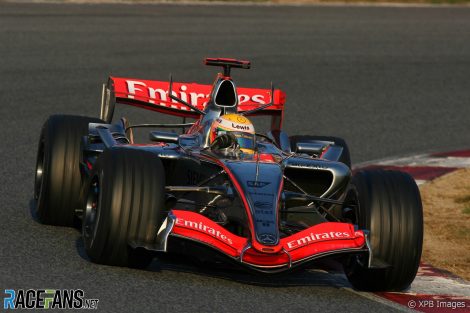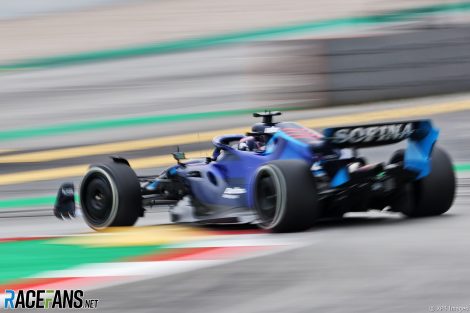Formula 1 drivers say their necks will be “falling off” in this weekend’s Spanish Grand Prix now they are no longer using the slow chicane at the end of the lap.
Drivers will tackle the original final two corners at the Circuit de Catalunya as they were used between 1991 and 2006.Fernando Alonso is the only driver in F1 today to have raced on the layout without the chicane. However others have driven the revised route.
Oscar Piastri tried the new end of the lap at a filming day for McLaren. “At that point it was rumoured it might happen so we just did a couple of laps,” he said.

“We had Saudi as our second race of the year, so that was quite the baptism of fire, for my neck anyway and I’m sure others,” he added. “But it’ll be a good challenge for us all and I think it will be much nicer to drive even if our necks are falling off.”
The chicane was installed in 2007, which was Lewis Hamilton’s first year in F1. However he drove the previous version during some earlier tests.
Advert | Become a RaceFans supporter and
“I remember testing here in 2006, my first test in the McLaren, and that was two, three, four days of the high-speed last corner,” said Hamilton. “And I remember I couldn’t hold my head up.

“And I remember getting into turn one and straight away not being able to hold my head up. I came back and said ‘no, my neck’s good…’. I was in so much pain, struggling to sleep at night.”
The chicane was originally added due to safety concerns. However today’s cars have to pass much tougher crash tests than they did 17 years ago and have safety enhancements such as the Halo. The run-off area and barriers at the exit of the final two corners have also been upgraded.
Several drivers expressed the hope that removing the chicane will make it easier for them to stay close to other cars at the end of the lap and increase overtaking opportunities on the long straight out of the last corner.
“I hope that we’re able to follow, with the cars we have, a bit better through the last two corners than we have the little Mickey Mouse chicane,” said Hamilton.
Advert | Become a RaceFans supporter and
Alexander Albon is enthusiastic about the change and believes removing the chicane will produce better racing with the current generation of F1 cars.

“It was always a bit of – I don’t want to call it an ugly piece of work, but it was tricky and it ruined the rest of the track because the flow was just so different to before. Not that I’ve driven it, but I will do soon.
“More than anything, it’s the racing that I hope is going to improve and it will do, I’m sure. Last year, you could always stay pretty close through [turns] 10 and 12 because of the lines you can take – always a bit different, you can always find a bit of clean air. If you went in tight through 10 or wide through 11, you could always offset the car in front.
“But once you go through 13, 14, 15, it was always single-line. You had to copy the same line.
“These high speed corners the car follows, with these regulations, not too bad. I reckon it’s going to be one of the easier overtaking tracks we go to this year, at least by our pre-race statistics. Maybe we’re wrong but let’s hope we’re not.”
However Albon also admitted he expects the change will suit the Williams chassis. “The removal of the chicane is going to help us a little bit more. Those three corners was always a bit of a tricky one for us, we’d always lose quite a lot of lap time through there. So getting rid of that is perfect.”
Bringing the F1 news from the source
RaceFans strives to bring its readers news directly from the key players in Formula 1. We are able to do this thanks in part to the generous backing of our RaceFans Supporters.
By contributing £1 per month or £12 per year (or the equivalent in other currencies) you can help cover the costs involved in producing original journalism: Travelling, writing, creating, hosting, contacting and developing.
We have been proudly supported by our readers for over 10 years. If you enjoy our independent coverage, please consider becoming a RaceFans Supporter today. As a bonus, all our Supporters can also browse the site ad-free. Sign up or find out more via the links below:
Advert | Become a RaceFans supporter and
2023 Spanish Grand Prix
- Ben Sulayem raises safety concerns over “too many people on the grid” at races
- Why Ferrari say their change in design is the result of “discipline”, not “copying”
- Hamilton and Russell were seeking tow from Sainz when they collided – Mercedes
- Red Bull’s Spanish GP diffuser update was ‘inspired by rivals’ including Williams
- Why McLaren always doubted second-row start in Spain would lead to points finish





Jere (@jerejj)
2nd June 2023, 9:57
While I’m not ruling out racing & overtaking improving, I don’t get what makes everyone think they’d (automatically) improve despite the fact following is generally harder through high-speed corners than slower ones.
Eau Rouge-Raidillon is an exception to the rule because of being flat-out & has a relatively slight radius.
Fast corners with tighter radiuses & taking full-throttle in race trim unguaranteed, the dirty air effect usually affects the following ability negatively.
Yes, the chicane didn’t help matters as intended back in 2007, but the chicane-less lap-end wasn’t necessarily any better for overtaking into T1, so I’ll have my doubts & reserve judgment until the race.
People thought similarly about Yas Marina’s & Albert Park’s changes, yet reality proved different.
Lap flow is the only thing guaranteed to improve.
As a secondary side note, Lewis’ first-ever F1 test occurred in Silverstone in 2004, so the 2006 case was only his first time driving an F1 car in Montmelo.
kpcart
2nd June 2023, 11:44
It should be easy flat out in this years cars with no lifting off the gas. Melbourne improved overtaking but made it too easy with drs, and made the lap far easier for drivers.
Jere (@jerejj)
2nd June 2023, 12:10
In qualifying, yes, but race with higher fuel loads could be another matter.
Maybe a little bit easier this year in year 2 with the altered configuration than in 2019 & before, but DRS didn’t male overtaking too easy.
For example, Max would’ve passed into the lead eventually anyway & some other drivers struggled to get by, only managing after a fair few laps.
Only Facts!
2nd June 2023, 11:38
Well, if the goal is to help DRS passes on the straight, the changes may be effective.
Being the leader in the first lap may not be so important anymore, which is a good thing, but that will hurt Alonso’s chances of attempting to dance in front of a RBR for 90 minutes.